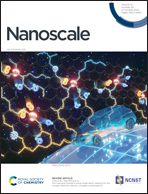Porphyrin nanotubes based on a hydrogen-bonded organic framework†
Abstract
Tubular structures offer a wide variety of applications; therefore, designing such materials with distinct dimensions is highly desirable yet challenging. In the current report, we have demonstrated the synthesis of a one-dimensional (1D) tubular assembly comprising porphyrin nanoring subunits. The porphyrin nanoring (PNR) 2 bearing ester groups was synthesized via Pt-mediated cyclization and then hydrolyzed to obtain PNR 3 with carboxylic groups. Under optimized conditions, porphyrin nanotubes (PNTs) were formed through hydrogen bonding between the carboxylic groups of 3. The morphology investigated by both SEM and TEM displayed well-defined arrays of nanotube bundles up to several micrometers long. Small crystals of PNTs were obtained by heating a solution of 3 in DMSO. High-resolution transmission electron microscopy (HR-TEM) accompanied by selected-area electron diffraction (SAED) exhibited a line of diffractions with d-spacing values of 6.17, 3.08, 2.07, and 1.57 Å. The miller indices of these diffractions could be assigned as 300, 600, 900, and 1200, respectively, suggesting that an ordered structure of 1D PNTs has been formed.



 Please wait while we load your content...
Please wait while we load your content...